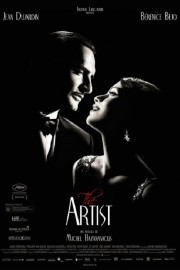The Artist
It would have been very easy for “The Artist” to be, simply, a gimmick movie: the first significant studio release in, perhaps, decades that was a silent film. Even if it turned out to be a gimmick movie in that respect, the film could easily (just by virtue of its release by the Weinstein Company) head straight on to the Oscar stage and pick up the Best Picture Oscar in February, because Hollywood loves a film that loves Hollywood. Thankfully, writer/director Michel Hazanavicius has more than just a high-concept up his sleeve.
The film stars Jean Dujardin as George Valentin, a silent film star in the vein of Douglas Fairbanks and, with his photogenic dog, Jake (a scene-stealer), Charlie Chaplin. As the film opens in 1927, Valentin is at the height of his career as an entertainer when he bumps into, literally, Pippy Miller (Berenice Bejo), a young dancer and fan of the actor. After they get their picture together on the front page of Variety, Miller charms her way into being a background dancer on one of Valentin’s films. Soon enough, she’s making her way up the Hollywood star roster as well. In 1929, however, fortunes change, and Hollywood is at a crossroads: the talking picture has taken over, and while Pippy is revved up for the proposition, Valentin is comfortable in the world of silence, and laughs at the notion of finally hearing dialogue.
In that last sentence, the whole dilemma and drama of “The Artist” is brought to the fore: as with the 1952 musical classic, “Singin’ in the Rain,” “The Artist” is about the transition from silent films to talkies. In the newer film, however, that transition is told through the painful riches-to-rags eyes of Valentin, who sees his prospects as a star deteriorate because of his inability to adapt to this beloved (and necessary) shift in cinematic history. As Valentin falls on hard times, Pippy becomes a star in her own right, but she’s never forgotten that push that Valentin gave her, even if Valentin feels like he’s been forgotten. Thankfully, he still has his faithful dog to keep him company, even after the economic realities of the times have forced him into selling all of his possessions…except his films.
Part of the greatness in “The Artist” lies in how Hazanavicius uses the silent film approach not as merely a clever conceit, but as a way of dramatizing the change Valentin sees in his fortunes. Only twice do we hear something beyond the lush, lovely score by Ludovic Bource, and in both cases, the effect the introduction of sound effects and dialogue has on the narrative is enriching. The early moments in “The Artist” are it’s weakest, when Hazanavicius tries too hard for the same ham-handed melodrama and comedic pratfalls that make silent cinema so distinctive. Once the times begin to shift as the world embraces sound, however, the film finds its footing, and builds to a romantic and joyous climax. Now that’s entertainment for the ages, if you ask me.










